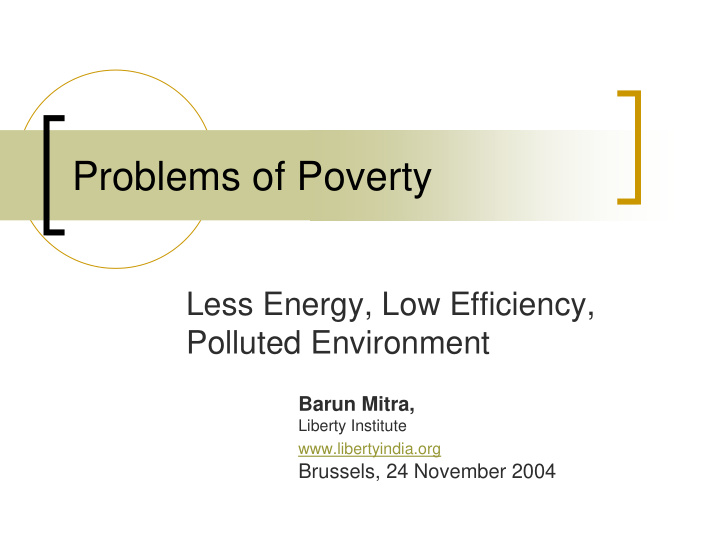



Problems of Poverty Less Energy, Low Efficiency, Polluted Environment Barun Mitra, Liberty Institute www.libertyindia.org Brussels, 24 November 2004
India on the Energy Map Commercial energy production and per capita, 1999 Country Commercial Energy Commercial energy use Production (thousand metric per capita (kg of oil tonnes of oil equivalent ) equivalent) USA 1,687,886 8159 China 1,056,963 868 Bangladesh 14,474 139 India 409,788 482 Liberty Institute, New Delhi 2
Energy in India Sl. No. Source of Energy 1970-71 1980-81 1990-91 2001-02 1. Commercial energy 47.67 75.19 151.43 210.83 production 2. Net imports 12.66 24.63 31.69 87.85 3. Total commercial 60.33 99.82 183.12 298.67 energy supply (1+3) 4. Primary non- 86.72 108.48 122.07 139.02 commercial energy supply 5. Total primary energy 147.05 208.30 305.19 437.69 supply (3+4) Unit: million tonnes of oil equivalent (MTOE) Liberty Institute, New Delhi 3
Problems of Poverty � Low energy consumption � Low energy efficiency � Higher energy dependence � High energy intensity � Higher environmental stress � Dirty environment � Higher Impact on health � Lower adaptability � Greater vulnerability to natural calamity Liberty Institute, New Delhi 4
Indoor air pollution Rural Kitchen Electricity, 0.18% Others, 9.66% LPG, 17.50% Traditional Fuel, 72.33% Liberty Institute, New Delhi 5
Lighting Indian Homes Others, 0.85% Kerosene, 43.30% Electricity, 55.85% Liberty Institute, New Delhi 6
Indoor air pollution – the toll Causes No. of deaths Acute respiratory infections-Age less than 310000-470000 5 years, Chronic obstructive pulmonary disease. Blindness-women (not death) and prenatal 50000-130000 effects Tuberculosis on women Cardiovascular disease-women asthma 50000-190000 Grand total: 410000-790000* *Total annual deaths in India for women and children under 5 in these disease categories in the early 1990s. Liberty Institute, New Delhi 7
Fuel Index Fuel type Weight Dung 1.00 Saw dust 0.97 Crop residue 0.96 Fuel wood 0.82 Coal 0.46 Charcoal 0.31 Kerosene 0.08 •90% of households in small villages rely on fuels like firewood, animal dung and Liquid Petroleum Gas 0.05 crop residue Biogas 0.04 •88% of rural women population used Electricity 0.05 these fuels for their daily cooking. The more convenient, efficient and cleaner the fuel, less is its weight. Since animal dung lies at lowest end, the other fuels are weighed with respect to dung. (Parekh, et al, 2003) Liberty Institute, New Delhi 8
Restricted economy, Greater vulnerability � Taxes and Tariffs reduce consumption and competitiveness and efficiency � Poor are most vulnerability to natural calamity � Lighting – Bulbs to CFLs – taxes, tariff, procurement policy � Automobile – 180% import duty, 50% taxes, � Fuel – 30-40% taxes on petroleum product � Refrigerator – CFC and frost free, energy efficient, but … � Floods – annually 1000s die in South Asia, in Florida toll ranges in 10s Liberty Institute, New Delhi 9
Income, Energy and Efficiency Share of World Income Low income group Middle countries income 3% Share of commerial energy group countries Low income 17% group countries High 13% income High income group group Middle countries countries income group 80% 51% countries 36% Liberty Institute, New Delhi 10
Declining significance of Energy 80.00 Value of energy as % of GDP,1980 70.00 Value of energy as % of GDP,1998 60.00 50.00 40.00 30.00 20.00 10.00 0.00 Thailand Kenya India China World Canada Netherland Germany United Kingdom Japan Malaysia Mexico Denmark USA Liberty Institute, New Delhi 11
Poverty Kills Today � Debate on global warming, shifts focus from problems of today to ‘day after tomorrow’ � Concerns about sea level rise in future, but thousands die each year due to floods today � Millions die today from preventable diseases of poverty, but focus is on diseases of the future Liberty Institute, New Delhi 12
Price of Oil – 1861 to 2001 50.00 100.00 $ 2002 $ money of the day 45.00 90.00 40.00 80.00 35.00 70.00 Constant US Dollar 2002 Current US Dollar 30.00 60.00 25.00 50.00 20.00 40.00 15.00 30.00 10.00 20.00 5.00 10.00 0.00 0.00 1861 1871 1881 1891 1901 1911 1921 1931 1941 1951 1961 1971 1981 1991 2001 Liberty Institute, New Delhi 13
US Energy Intensity 120000 2000 Gross Domestic Product (GDP) Petroleum and Natural Gas Consumption per Dollar of GDP Other Energy Consumption per Dollar of GDP Energy Consumption per Dollar of GDP 1800 100000 1600 Energy in 100 BTU per USD (2000) 1400 GDP in 10 billion USD (2000) 80000 1200 1000 60000 800 40000 600 400 20000 200 0 0 1973 1974 1975 1976 1977 1978 1979 1980 1981 1982 1983 1984 1985 1986 1987 1988 1989 1990 1991 1992 1993 1994 1995 1996 1997 1998 1999 2000 2001 2002 2003 Year Liberty Institute, New Delhi 14
Energy Abundance � Higher energy consumption � Higher energy efficiency � Lower dependence on energy resources � Lower energy intensity � Lower environmental stress � Cleaner environment � Lower impact on health � Higher adaptability � Lower vulnerability to natural calamity Liberty Institute, New Delhi 15
Conservation through Consumption � Development is the Key that unlocks the potential of increased consumption � Economic freedom creates the competitive environment for harnessing human creativity leading to efficiency gains Liberty Institute, New Delhi 16
Recommend
More recommend